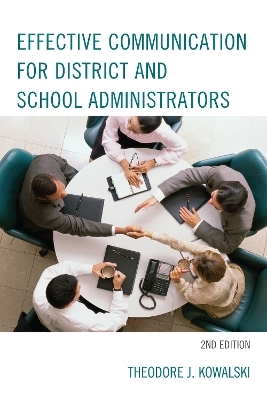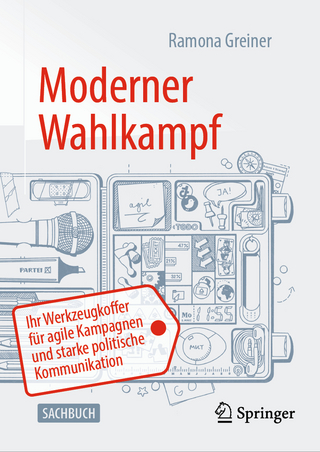
Effective Communication for District and School Administrators
Rowman & Littlefield (Verlag)
978-1-4758-0885-8 (ISBN)
The book is a unique and necessary contribution to the literature on school administration. Research, theory, and practice were melded to produce a book that can be used as a primary or supplemental text or as professional growth resource for practitioners. Communication scholars, especially since 1990, have concluded that competence must be defined and studied in the context of professions. As such, a growing number of medical schools, law schools, and business schools have integrated communication into their curricula. This book provides a resource for such integration into the study and practice of district and school administration.
Theodore J. Kowalski is Professor and the Kuntz Family Endowed Chair in Educational Administration at the University of Dayton. A former teacher, principal, superintendent, and college dean, he is the author of 31 books and approximately200 book chapters, journal articles, and research studies.
Preface
Chapter 1: Communication Basics
·Introduction
·Communication Characteristics
Form
Flow
Status
Action
Symmetry
·Theoretical Perspectives
Classical theories
Human relations theories
Systems theories
·Synthesis
·Reflective questions
Chapter 2: Communicating Competently
·Introduction
·Communicative behavior
Institutional dimension
Personal dimension
·Avoiding common problems
Insufficient forethought
Organizational constraints
Personal constraints
Inadequate evaluation
·Complementary and Relational Communication
·Communicative competence
·Synthesis
·Reflective Questions
Chapter 3: Leadership and Relationships
·Introduction
·Understanding Leadership
Leadership, management, and administration
Formal versus informal leadership
·Importance of Relationships
Communicative behavior and relationships
Relationships matter
·Synthesis
·Reflective Questions
Chapter 4: Problem Solving, Decision Making, and Critical Thinking
·Introduction
·Problem Solving
Problem framing
Stages
·Decision Making
Types of decisions
Group decision making
·Critical Thinking
Language and communication
Reflection
·Synthesis
·Reflective Questions
Chapter 5: Organizational Communication
·Introduction
·Schools as Loosely Coupled Organizations
Schools and coupling
Advantages and disadvantages of loose coupling
Contemporary perspective
·Communication Networks
Formal versus informal networks
Bridges or buffers
Beneficial properties
Constructing and applying evidence
Evaluating networks
·Synthesis
·Reflective Questions
Chapter 6: School Governance and Democratic Administration
·Introduction
·Citizen Involvement in School Governance
Democratic localism
Representative democracy
Current conditions
·Democratic Administration
Historical context
The second coming
Democratic administration and communication
·Synthesis
·Reflective Questions
Chapter 7: Climate, Culture, and the Learning Organization
·Introduction
·School Climate
Elements
Closed and open climates
·School Culture
Elements
Effects
Culture and communication
Why culture change is difficult
·School as a Learning Organization
Organizational learning
A learning culture
·Synthesis
·Reflective Questions
Chapter 8: Initiating and Sustaining Planned Change
·Introduction
·Contemporary School Reform
1983-1989
Post 1989
·Change Processes
Empirical-rational
Power-coercive
Normative-reeducative
·Process Issues: Involvement and Communication
Inclusiveness
Communicating appropriately
·Synthesis
·Reflective Questions
Chapter 9: School Partnerships
·Introduction
·Understanding Partnerships
Definition
Levels of Autonomy
Operational Characteristics
·Motives
Community stakeholders
Educators
Collaborating organizations/groups
·Why Partnerships Succeed or Fail
Effective Practices
Potential Pitfalls
·Synthesis
·Reflective Questions
Chapter 10: Managing Conflict
·Introduction
·Organizational Conflict
Defining conflict
Conflict in schools
·Sources, Types, and Contaminants
Sources and types
Contaminants
·Management System and Strategies
System
Strategies
·Conflict Management and Communication
·Synthesis
·Reflective Questions
Chapter 11: Conducting a Referendum Campaign
·Introduction
·Key Administrative Responsibilities
·Verifying the need
·Marketing
·Conducting the Campaign
Organization
Process
Potential pitfalls
Evaluating outcomes
·Importance of Communication
·Synthesis
·Reflective Questions
Chapter 12: Relationships with Media Personnel
·Introduction
·Working with Journalists
Preparation
Making relationships positive
·Initiating Media Coverage
Press releases
Press conferences
·Electronic Media Interviews
Video
Audio
·Crisis Communication
Before the crisis
During the crisis
After the crisis
·Synthesis
·Reflective Questions
| Verlagsort | Lanham, MD |
|---|---|
| Sprache | englisch |
| Maße | 155 x 227 mm |
| Gewicht | 340 g |
| Themenwelt | Sozialwissenschaften ► Kommunikation / Medien ► Kommunikationswissenschaft |
| Sozialwissenschaften ► Pädagogik | |
| Wirtschaft ► Betriebswirtschaft / Management | |
| ISBN-10 | 1-4758-0885-2 / 1475808852 |
| ISBN-13 | 978-1-4758-0885-8 / 9781475808858 |
| Zustand | Neuware |
| Haben Sie eine Frage zum Produkt? |
aus dem Bereich


